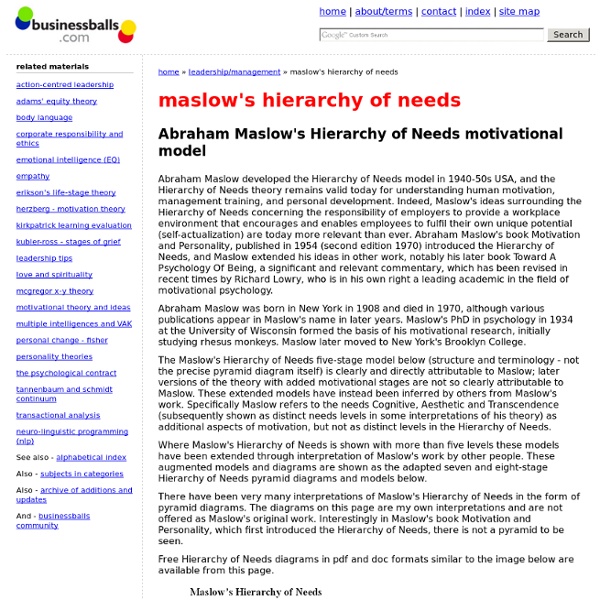Abraham Maslow's Hierarchy of Needs and diagrams of Maslow's motivational theory - pyramid diagrams of Maslow's theory

Total Quality Management Pitfalls
Undefined Role Of Middle Management If you are thinking of introducing TQM into you organisation, make sure that all influential people in management are on your side. Especially middle management who are pivotal in any organisation: They will act like filters to lower groups in the organisation: they communicate much more frequently with lower management than the top-level people. There are two ways to deal with this: Get middle management to start participating at an early stage of your implementing the TQM. Alternatively, if middle management is too opposed to TQM and the goals of top-management, then certain re-organisation may be necessary. The Annoying Quality Slogan Slogans can end up having a disastrous effect on the motivation of employees. Who hasn’t experienced employees quoting a company slogan or title of some “rationalisation project” and rolling their eyes at the same time. As Henry Ford once said “You can’t build a reputation on something you haven’t done yet”.
Abraham Maslow
Dr. C. George Boeree Maslow (en français: Silvia Moraru) Biography Abraham Harold Maslow was born April 1, 1908 in Brooklyn, New York. To satisfy his parents, he first studied law at the City College of New York (CCNY). He and Bertha moved to Wisconsin so that he could attend the University of Wisconsin. there working with Harry Harlow, who is famous for his experiments with baby rhesus monkeys and attachment behavior. He received his BA in 1930, his MA in 1931, and his PhD in 1934, all in psychology, all from the University of Wisconsin. He began teaching full time at Brooklyn College. Maslow served as the chair of the psychology department at Brandeis from 1951 to 1969. He spend his final years in semi-retirement in California, until, on June 8 1970, he died of a heart attack after years of ill health. Theory One of the many interesting things Maslow noticed while he worked with monkeys early in his career, was that some needs take precedence over others. 1. 2. 3. 4. Self-actualization
Quality Gurus |
the plowden report
contents: introduction - backround to the plowden report · what plowden said about the curriculum · the plowden report - a chequered history · criticism of the plowden report · plowden today · bibliography · links · how to cite this article Introduction: background to the Plowden Report In August 1963 the then Minister of Education, Sir Edward Boyle, asked the Central Advisory Council for Education (England) 'to consider primary education in all its aspects and the transition to secondary education.' The Council, under the Chairmanship of Bridget Plowden, presented its report to the Secretary of State for Education and Science, Rt. Hon Anthony Crosland, in October 1966. There had not been a thorough review of primary education in England since Sir Henry Hadow's Report of 1931. The context in which the Committee worked was characterised by an increasingly liberal view of education and society. The Plowden Report emphasises the need to see children as individuals. Plowden today References
Related:
Related:



